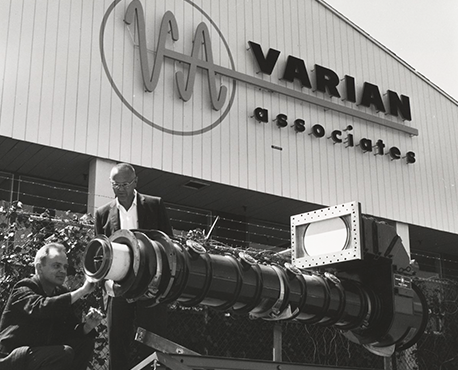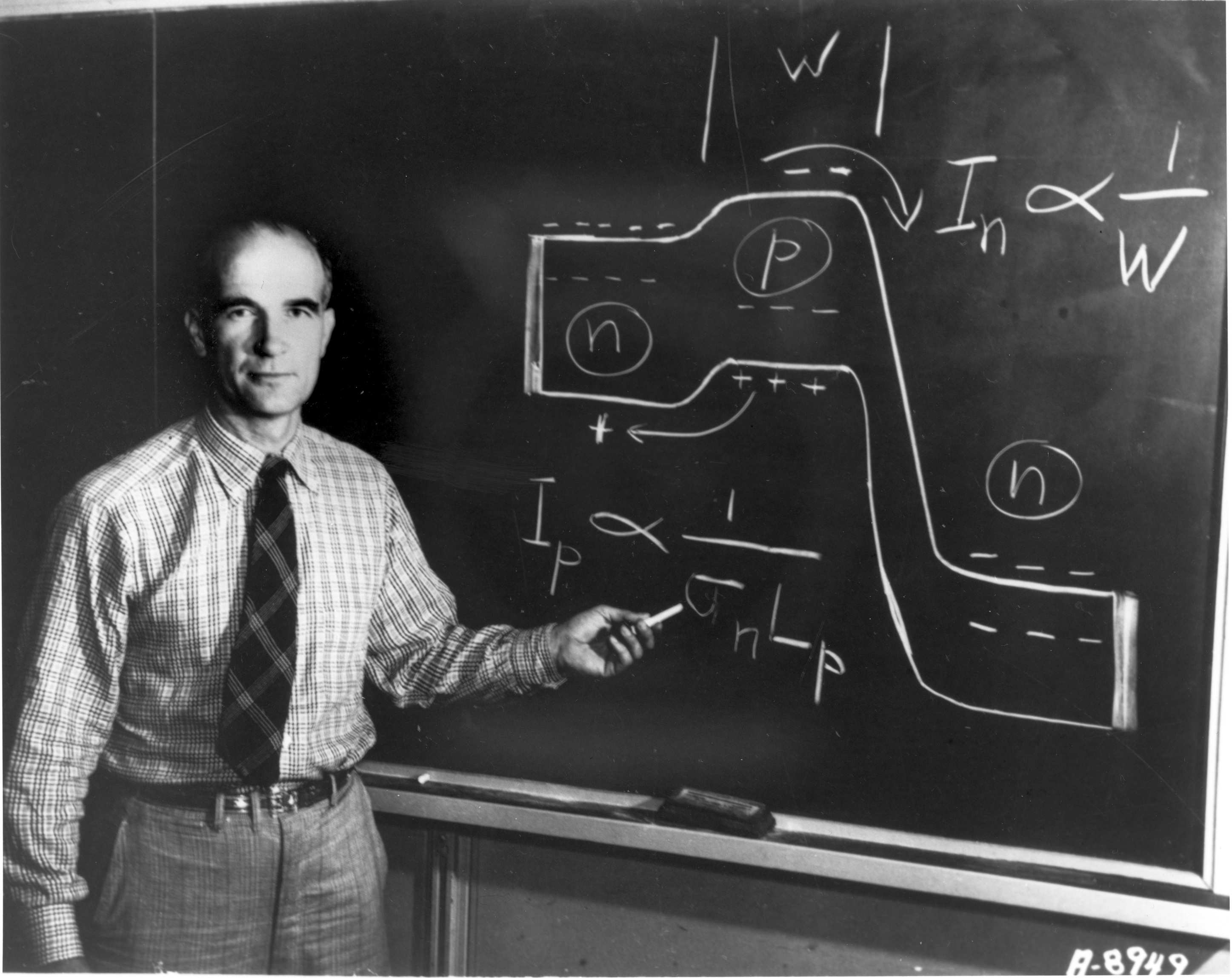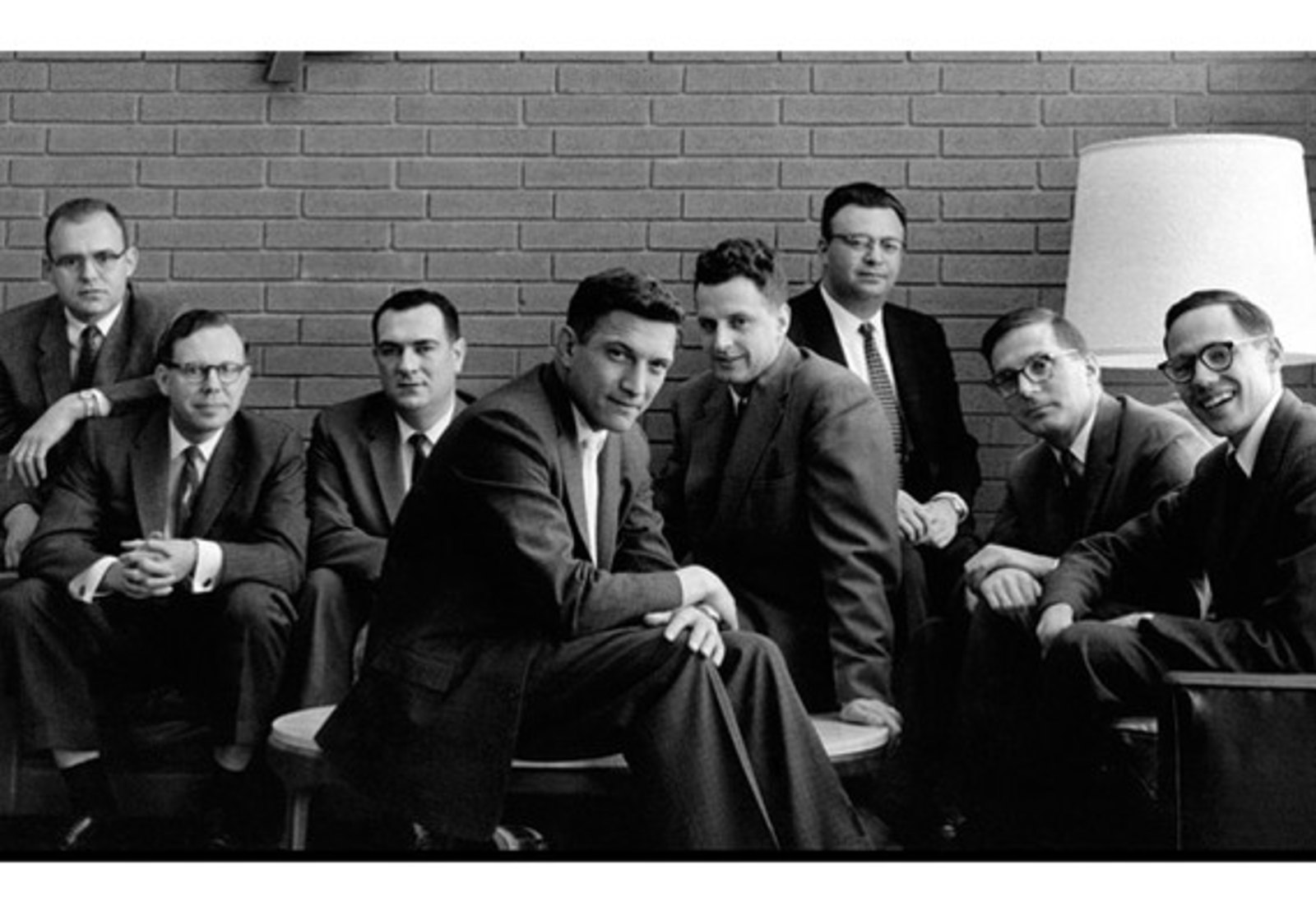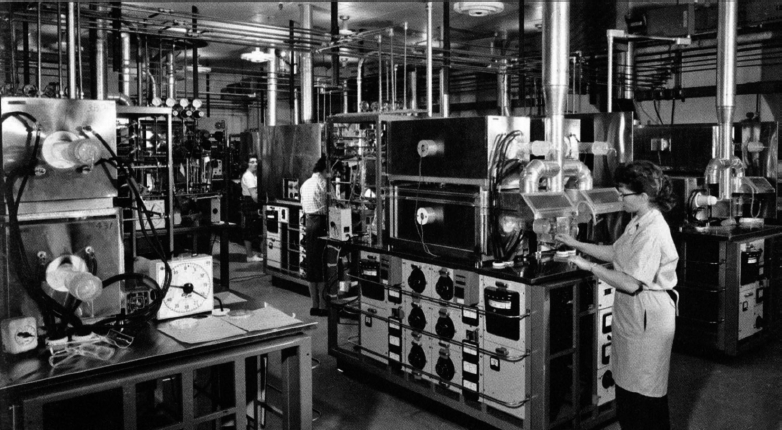In the 50s - 70s of the twentieth century, Stanford University was a major point of attraction for talent, technology, and large military orders. Applied laboratories and industrial park formed its innovative ecosystem.
By the end of the 60s, the centralized management of innovations, carried out by large corporations and the state, begins to yield.
A new generation of technology entrepreneurs and managers is entering the historical arena. By his efforts, the ecosystem of Stanford University is growing rapidly, turning into a fundamentally different ecosystem, called "Silicon Valley".
 Map of the Valley. 1981
Map of the Valley. 1981The scientific and technical progress is influenced by factors that are difficult to predict. This is its own logic of scientific and technological development, and market conditions, and private initiative, and "His Majesty Chance."
The same can be said about innovation ecosystems. Innovative ecosystems are created by people who have a clear vision of the functioning of the ecosystem. However, over time, ecosystems begin to develop independently, ignoring the plans of their own creators.
A good confirmation of this thesis is the
history of the Novosibirsk Academgorodok in the USSR . However, it is most vividly illustrated by the history of the most famous innovation ecosystem, Silicon Valley.
<Tl; dr>
Summary:The father of Silicon Valley is called Fredrik Terman, who for many years held various leadership positions at Stanford University. Terman was engaged in the purposeful development of Stanford University as an innovation ecosystem.
Terman actively involved academic scientists in work on applied projects, and also actively sought customers, mainly among the military departments and firms of the US military-industrial complex.
Under his leadership, Stanford Industrial Park was created, where organizations such as NASA, Lockheed and IBM, could create laboratories and experimental production of new high-tech products with Stanford. The main technological focus in the 1950s-1960s was radio tracking and radio suppression systems for the needs of the Cold War.
However, starting from the 1960s, an area of semiconductor electronics that had hardly seemed to be the most promising was given an unexpected rise. Semiconductor microelectronics rose to its feet and strengthened without the influence of Terman and his associates, and the share of military order in their products, although significant, was constantly decreasing.
In the production of semiconductor microelectronics, new forms of financing business projects and their management are being created. At first it is the creation of relatively autonomous subsidiaries of large firms such as Fairchild or Texas Instruments, and a little later, since the 1970s, the creation of completely independent companies funded by business angels and venture funds.
New values of technological entrepreneurship, community and network of trust develop independently. Since the end of the 1970s, a new ecosystem, dubbed “Silicon Valley”, has independently grown on the site of the former ecosystem of Stanford University and outgrows it quantitatively and qualitatively.
</ Tl; dr>MIT West Coast
During the Second World War, Fredrik Terman, a graduate of Stanford University, led a project at Harvard to create "electronic weapons": devices that interfere with enemy radar. The use of such devices has dramatically reduced the loss of the US Air Force during the bombing of Germany and Japan.
 Fredrik Terman
Fredrik TermanStanford University during the War had relatively few military orders. The leaders were then - MIT, Harvard, Princeton and others.
Terman's connections enabled him to attract many leading scientists and engineers, and then talented students, to Stanford by making MIT on the West Coast from Stanford. The main research focuses were selected: radar and electronics.
The Korean War brought huge military orders to Stanford. In addition to the “fundamental,” conducting research in the electronics laboratory (Electronics Research Laboratory), a huge weapons applied electronics laboratory (Applied Electronics Laboratory) was created, serving the military order. The main goal is the development of systems capable of incapacitating the powerful air defense systems of the USSR and allied countries.
 Electronics Research Laboratory. 1951
Electronics Research Laboratory. 1951In addition, the US military feared a surprise attack by the USSR. Therefore, the task was to constantly monitor Soviet aircraft and fleet.
In 1955, when Terman became the rector, two laboratories: fundamental and applied, were merged into the General Systems Engineering Lab. They worked on scientific and technical tasks commissioned by various US intelligence agencies and military departments. In addition, prototypes of radar and radio jamming systems were created on the basis of new studies.
Industrial park
Terman created the conditions for the convergence of science and production. In 1951, he created the so-called Stanford Industrial Park, which in subsequent years housed the production of large technology firms (often working on military orders), such as Varian Associates, General Electric, Hewlett Packard, Kodak, Lockhead, IBM, Xerox.
 Varian Associates - manufacturer of tube electronics. The first resident of the Industrial Park. 1951
Varian Associates - manufacturer of tube electronics. The first resident of the Industrial Park. 1951Terman strongly supported the idea of creating new laboratories and firms in the park. As Terman himself recalled, “I inspired our new, young scientists to go outside and get acquainted with the local industry with those people in it who did interesting and creative things. I also helped industrialists to know the university, get acquainted with what is happening at Stanford ... ”. (Tajnai, 1985)
Terman contributed to the emergence of new firms, helped to attract resources and funding for this.
For example, in 1957, the oil company Kern County Land contacted Terman and expressed a desire to invest in the creation of a company for the production of military electronics. Terman linked them to the director of the laboratory of electronic devices, Watkins, who in his opinion could have taken place as head of production. Watkins and his colleague Johnson, with the help of Kern County Land, created one of the most financially successful Stanford firms of the 1960s, Watkins-Johnson. (Kenney, 2000)
On the areas of the industrial park, new subdivisions of already existing firms appeared. So, in 1956, Terman convinced V. Shokli, the inventor of the transistor, to return to his hometown Palo Alto and create the Shockley Transistor Laboratory (owned by Beckman Instruments), in which he would produce his 4-layer diodes.
“The growth atmosphere was infectious; Terman continued to persuade his graduates to start their own enterprises, and scientists and teachers continued to take part in them through counseling, investment, and the founding of their own companies. ”(Tajnai, 1985)
 The inventor of the transistor, William Shockley
The inventor of the transistor, William ShockleyThis atmosphere began to attract not only scientists and engineers, but also enterprising people and financiers from the East Coast. Although in the 50s and 60s of the twentieth century there were no generally accepted financing schemes for new technological enterprises, progressive-minded financiers were looking for new ways of investing and lending.
Direct investments of large technology firms in production on the territory of the industrial park, as well as individual experimental investments in new firms, solved the issue of financing new industrial ecosystem enterprises in the 50s - 60s.
Stanford University Ecosystem 50s - 60s
In the 50s and 60s of the twentieth century, Stanford University with its laboratories and industrial park was not close to what is now called Silicon Valley.
Major investments and orders were related to the US military complex. The source of them, with rare exceptions, was either the state or large corporations producing military equipment. Until the 70s of the twentieth century, most of the research laboratories and technology firms existed and developed thanks to the military order, especially for highly complex devices that could effectively damage Soviet military facilities and anti-aircraft and anti-missile defense equipment.
According to Steve Blank, who
reviewed the history of the Valley in the Cold War era, the main achievements of Stanford and its associated laboratories and enterprises of the 50s and 60s were not U2 transistors or processors.
 U2 reconnaissance aircraft
U2 reconnaissance aircraftBlank argues that the link between the Stanford ecosystem and the military customer was based on Terman’s personal connections. So he sees his strategy:
- Present in all possible military councils in order to build a network of connections.
- Maintain contact with all military customers. To create in the walls of Stanford interesting military prototype devices.
- If potential customers like the prototype, convince a student or other researcher to organize production.
- Convince university staff to take seats on the board of directors of new firms so that they can better know about the industry and acquire business competencies.
- Provide space for offices and industries in the industrial park, to be sure that everyone is close to each other.
The described strategy provided the flexibility to work with military customers, as well as external incentives for the development of technologies, involved more and more highly qualified specialists in it.
 “I like most of all to help build something new, taking a poorly formulated undertaking and making from it what it could be” - F. Terman
“I like most of all to help build something new, taking a poorly formulated undertaking and making from it what it could be” - F. TermanIn the period of the 50s – 60s, such important properties for Silicon Valley as orientation to a wide market and ease of attracting foreign investments were poorly represented.
On the other hand, as early as the 1950s and 1960s, the orientation of Stanford scientists toward the application of scientific knowledge in practice, the creation of new enterprises and firms began to appear. An atmosphere of cooperation and trust uncharacteristic for the US East Coast of the mid-twentieth century appeared.
Thus, it can be argued that in the 50s and 60s Terman created the ecosystem of Stanford University. Its atmosphere attracted a fairly large number of talented, creative and courageous people who were ready to try to embody new ideas in the field of science, technology, business, and finance.
Transistor and Silicon Valley
The military order, often formed due to Terman's connections, dominated throughout the 50s and 60s. However, since 1961, the total volume of the military order almost did not grow. From this point on, the creation of a fundamentally new ecosystem began to pass from the hands of a narrow group of Terman and his entourage into the hands of a larger group of private investors and entrepreneurs aimed at developing the market for civilian technologies. (Blank)
Throughout the late 1950s and 1960s, the semiconductor microelectronics industry received rapid growth. It produced high-tech products: transistors, diodes, microchips, which served as "building blocks" for computers and automation systems, both military and civilian.
 A transistor, a semiconductor triode, is a radioelectronic component of a semiconductor material, usually with three pins, capable of controlling a large amount of current in the output circuit from a small input signal, which allows it to be used for amplifying, generating, switching and converting electrical signals (wiki)
A transistor, a semiconductor triode, is a radioelectronic component of a semiconductor material, usually with three pins, capable of controlling a large amount of current in the output circuit from a small input signal, which allows it to be used for amplifying, generating, switching and converting electrical signals (wiki)As noted earlier, in 1956, William Shockley, one of the creators of the transistor and the Nobel laureate, created his own laboratory in Palo Alto. “Shockley started a rumor that he decided to create the most advanced transistors in the industry ... and that he is looking for the best and brightest young scientists who will help him change the world <...>. Thanks to his scientific reputation, “his appeal to talented young scientists received a response in the form of a storm of resume, from which he chose eight young people with extraordinary — as history will show — talents, including two with world-class potential ... Shockley had a special gift in reading summary and biographical references ”(Malone, 2015). However, his character and leadership style, primarily the lack of confidence in the work of employees, hindering their creative endeavors, proved so unacceptable for his talented employees that they fled from him. One of the most interesting ideas going against the ideas of Shockley was the idea of using more common silicon, instead of the more expensive germanium, as a semiconductor transistor.
 "The Treacherous Eight" of the founders of Fairchild Semiconductors
"The Treacherous Eight" of the founders of Fairchild SemiconductorsOne of the employees, Eugene Kleiner, "took it upon himself to find a company that wants to hire the entire team." He got in touch with a friend of his father who works for the investment company Hayden, Stone & Company in New York. They were interested in "a new member of the company, quite ambitious to achieve fame: Arthur Rock" (Malone, 2015). Hayden, Stone & Company "saw this as an opportunity to try out a new investment model that they developed: Hayden, Stone & Company in this model would not be a direct investor, it would be an intermediary between corporate investors and this new team" (Malone, 2015), which unexpectedly offered to create their own company. Sherman Fairchild, an inventor and billionaire from the East Coast, agreed to invest in a new company called Fairchild Semiconductors in the summer of 1957, provided that he could fully redeem it within 3 years if it was successful. (Berlin, 2001) Fairchild took advantage of the right of redemption already in 1959 after a successful transaction for the supply of transistors for IBM.
Fairchild Semiconductors, with the direct participation of immigrants from Shockley's laboratory, primarily R. Neuss, who served as director of science, became the leader in this new industry between 1959 and 1965. "The number of transistors produced by American firms increased 275 times from 1957 to 1965." (Berlin, 2001)
 One of the Fairchild workshops in the 1960s
One of the Fairchild workshops in the 1960sFairchild Semiconductor had a number of strong competitors, such as Motorola and Texas Instruments. In the mid-1950s – early 1960s, these corporations were also actively interested in the possibilities of semiconductors and opened their own units that were engaged in research and development in this area.
The transistor market was broad and not limited to military orders. “A two-level semiconductor market has emerged: on the one hand, these are tested products that are available at very low prices, produced in very large volumes and have a small added value (margin). These devices were usually used in the entertainment market, for example, as parts of radios, and were sold for less than a cent. On the other hand, there were devices that were newer and more technically advanced, which were produced in small parties and sold at a higher specific profit (profits). These devices were used for military applications and even in the growing computer market. ”(Berlin, 2001)
This meant that manufacturers, including Fairchild, had to be both a mass producer and a large-scale research organization. (Berlin 2001)
The departments of R & D (research and development) companies needed to constantly, in a highly competitive environment, design new types of semiconductor devices.
In Fairchild Semiconductors, there were also important changes in the understanding of the company's products itself, which are key to modern high technologies. It turned out that the company creates not just devices, but specialized high-tech products, including detailed technical descriptions and instructions, as well as technical support from Fairchild specialists.
 So in the 60s looked "landing page"
So in the 60s looked "landing page"The customers of the products were manufacturers of radio equipment, computers, various military companies, and the end users were engineers creating end devices with the help of transistors. “The company provided customers with unsurpassed technical support, for example, providing detailed technical manuals for each product that were so popular that Fairchild Semiconductor even distinguished them when advertising their products. In 1964, Fairchild Semiconductors changed the industry-standard <...> product-based marketing structure to a market-based structure. That is, instead of sales managers of diodes and transistors, Fairchild now had individual managers in the consumer electronics market, and managers in the military equipment market. ” (Berlin 2001)
During the 60s and 70s, about 65 microchip companies were established in the Palo Alto area. The most famous of them, Intel, was organized by people from the Shockley and Fairchild laboratories, R. Neuss and G. Moore.
Venture
By the beginning of the 1970s, a financing scheme was found, which allowed connecting new start-up firms and financial resources, which formed the basis of the institution of venture capitalism and allowed to attract private capital from outside. Its essence is to provide new technology firms with capital in exchange for its shares, counting on getting super-profits from the subsequent sale of the shares of this firm (on the stock exchange or another company).
The pioneers in the new model are A. Rock, T. Davis, who created the first successful venture capital fund in California in 1961. However, it was rather a single phenomenon - it seemed very risky to other financiers. According to the memoirs of A. Roca, other venture funds began to open only in the interval of 1968–1970, when the Roca and Davis Foundation showed over-profits after they sold their shares of Scientific Data Systems to Xerox for almost $ 1 billion. (Gupta, 2000)
 Sigma 7 Computer Scientific Data Systems
Sigma 7 Computer Scientific Data SystemsVenture capitalism developed rather slowly. The total amount of venture capital investment in the Valley became comparable in order with the sum of defense orders only in the 80s.
Over a period of 20 years, the so-called Silicon Valley has grown. In addition to the old Ecosystem of Stanford University, which is powered by military and state orders, it also began to include a completely new post-industrial ecosystem based on technological entrepreneurship and private investment. The new ecosystem has grown not only in qualitative but also in quantitative terms. Offices and research centers of new companies began to appear not only in Stanford University and its environs, but throughout the entire area of the San Francisco Peninsula between San Mateo and San José (the distance between these locations and towns is about 45 km).
Results
During the Second World War, the success of many scientific mega-projects, such as nuclear, gave rise to a belief in the controllability and predictability of scientific and technological progress.
However, the post-war experience of both Silicon Valley in the USA and, for example, the Akademgorodok of Novosibirsk in the USSR shows that technological and organizational development cannot be directly controlled over a long time interval.
Technologically, in Silicon Valley, it all started with a military order, “jammers” and spy planes, but then completely unplanned moved to the area of mainly civilian microelectronics and automation, and after the 80s, and completely in the field of software.
Organizationally, everything began with large applied laboratories and relations with military customers from such managers as Terman. However, then the initiative, both in the search for customers and investors, and in the organization of development and business as a whole, passed into the hands of technological entrepreneurs.
Development management has become decentralized, and the future is uncertain.
Literature
Berlin Leslie R. Robert Noyce and Fairchild Semiconductor, 1957-1968 [Journal] // Business History Review. - Boston: The President of Harvard College, 2001. - 1: Vol. 75
Blank S. The Secret History of Silicon Valley [Online]. -
steveblank.com/secret-history .
Gupta Udayan Done Deals: Venture Capitalists Tell Their Stories [Book]. - [sl]: Harvard Business Review Press, 2000.
Kenney Martin Understanding Silicon Valley: Anatomy of An Entrepreneurial Region [Book]. - [sl]: Stanford Business Books, 2000. - p. 304.
The Law of Business and Social Development. [Book Section] // Handbook of Economics and Technology Change / book auth. P. Stoneman. - Oxford: Blackwell Publishers, 1995.
The Father of the Carolyn E. Fred Terman, the Father of the Silicon Valley [Journal] // IEEE Design & Test of Computers. - 1985. - 2: Vol. 2
Malone Mark The Intel. As Robert Noyce, Gordon Moore and Andy Grove created the most influential company in the world [Book]. - Moscow: Eksmo, 2015. - p. 528.